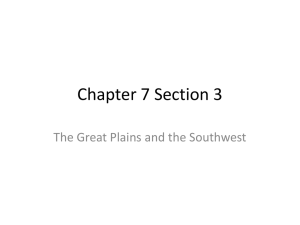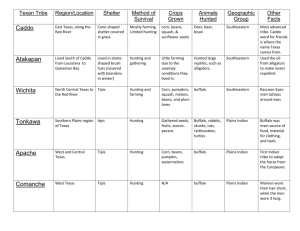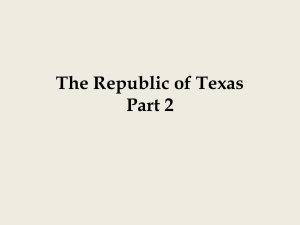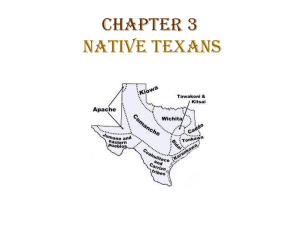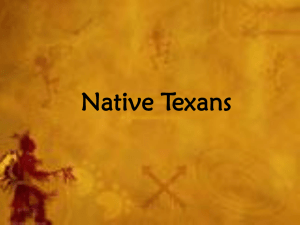Chapter 4 Vocabulary Lesson 1 Ancient People Nomad
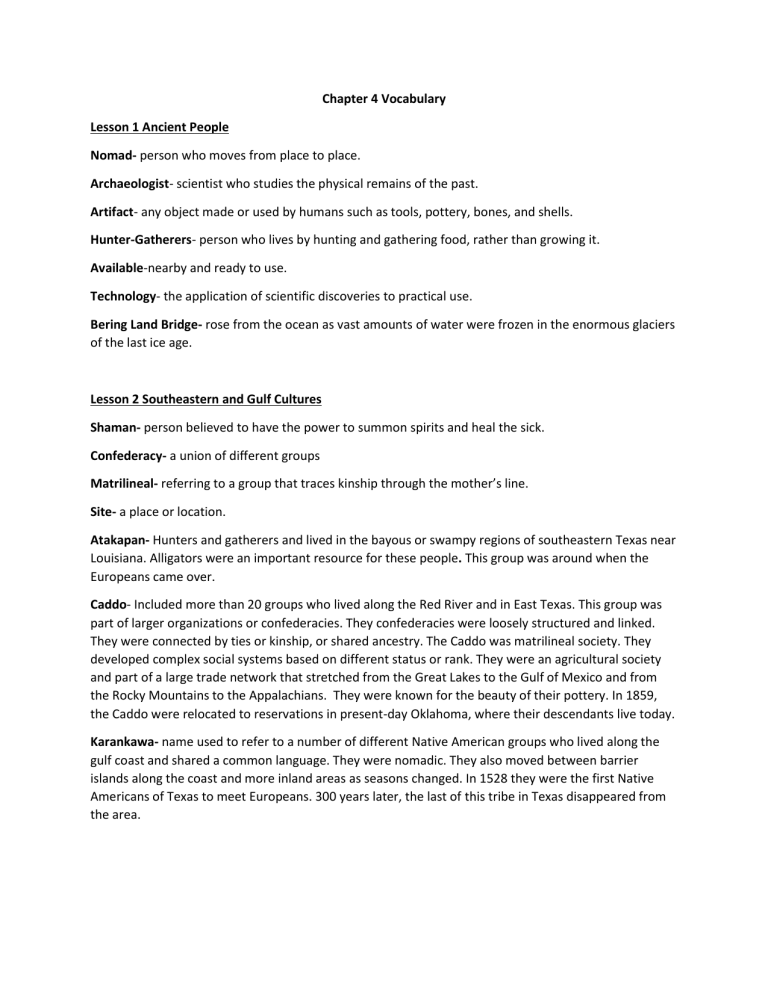
Chapter 4 Vocabulary
Lesson 1 Ancient People
Nomad- person who moves from place to place.
Archaeologist- scientist who studies the physical remains of the past.
Artifact- any object made or used by humans such as tools, pottery, bones, and shells.
Hunter-Gatherers- person who lives by hunting and gathering food, rather than growing it.
Available-nearby and ready to use.
Technology- the application of scientific discoveries to practical use.
Bering Land Bridge- rose from the ocean as vast amounts of water were frozen in the enormous glaciers of the last ice age.
Lesson 2 Southeastern and Gulf Cultures
Shaman- person believed to have the power to summon spirits and heal the sick.
Confederacy- a union of different groups
Matrilineal- referring to a group that traces kinship through the mother’s line.
Site- a place or location.
Atakapan- Hunters and gatherers and lived in the bayous or swampy regions of southeastern Texas near
Louisiana. Alligators were an important resource for these people. This group was around when the
Europeans came over.
Caddo- Included more than 20 groups who lived along the Red River and in East Texas. This group was part of larger organizations or confederacies. They confederacies were loosely structured and linked.
They were connected by ties or kinship, or shared ancestry. The Caddo was matrilineal society. They developed complex social systems based on different status or rank. They were an agricultural society and part of a large trade network that stretched from the Great Lakes to the Gulf of Mexico and from the Rocky Mountains to the Appalachians. They were known for the beauty of their pottery. In 1859, the Caddo were relocated to reservations in present-day Oklahoma, where their descendants live today.
Karankawa- name used to refer to a number of different Native American groups who lived along the gulf coast and shared a common language. They were nomadic. They also moved between barrier islands along the coast and more inland areas as seasons changed. In 1528 they were the first Native
Americans of Texas to meet Europeans. 300 years later, the last of this tribe in Texas disappeared from the area.
Wichita- Arrived in the 1700’s from what is now Oklahoma. They settled in Northern Texas and at first traded with people in Louisiana and with the Comanche to the west. They farmed and hunted. They were not Nomads and lived in villages in houses with grass outer coverings. The Wichita were moved to a reservation in Oklahoma in the late 1800’s.
Coahuiltecan- lived in the dry South Texas Plains. They were nomadic. Their environment was harsher than that of the coastal groups and their struggle for food was constant. By the 1800’s many of these people had died from diseases brought from the Europeans. Others had joined other groups or moved to Mexico.
Status - a social rank or position.
Lesson 3 Plains and Puebloan Cultures
Adobe- a mix of sun-dried earth and straw used to build houses.
Patrilineal- referring to a group that traces kinship through the father’s line.
Tepees- a portable homemade of tanned bison hides fastened to a framework of poles.
Middleman- a dealer or agent acting as a go –between for the producers of goods and retailers or consumers.
Distinct- Notable; unique
Migrated- to move from one place to another.
Jumano- Split between the Plains and Puebloan cultures. The Jumano acted as middlemen, or the go between for the eastern farming tribes, such as the Caddo and the Puebloan peoples of New Mexico.
They traded agricultural products. They were known for their quality of bows and arrows that they traded too. They had distinct striped markings on their faces that made them easy to recognize. They probably used these markings to show to others they were peaceful traders.
Tonkawa- plains group that lived in tepee villages throughout the Southern Plains. They were nomadic hunter sand fought many other groups, including the Apache, Caddo and Wichita.
Apache- Speak a language similar to that of Native Americans in Northwestern Canada and Alaska. For this reason, scientists believe the ancestors of the Apache came from the far north and migrated south along the Rocky Mountains. They settled in the Southwest from present-day Texas to Arizona and south to Mexico. Two groups lived in Texas: the Mescalero in West Texas and the Lipan in Central Texas. The
Apache relied mainly on Bison and were among the first Native American groups to adopt the use of horses from the Europeans. Horses were not a part of the Native American culture until the Europeans came over. Today, most Apaches live on reservations in New Mexico.
Comanche- came to Texas in the early 1700’s and lived on the prairies, plateaus, and plains of western
Texas until the late 1800’s. Their territory, called the Comancheria, was a vast land that stretched from northern Mexico to Kansa and from Texas to New Mexico. They originally lived in the Rocky Mountains.
When the Comanche began to use horses, they became superb hunters. The Comanche were divided into many bands. Each had its own leaders and council of older men who made the important decisions.
By the 1870’s, from the destruction of the buffalo herd, the loss of many horses, and the growing numbers of white settlers forced them to move to reservations in present –day Oklahoma.
Kiowa- like the Comanche, this group originally lived in the Rocky Mountains until they learned to ride horses and moved onto the Plains. They were nomadic. They were known for having the largest horse herds on the Plains. They made a peace agreement with the Comanche and often supplied them with horses. By the 1870’s as a result of the declining loss of bison due to the white Americans, the Kiowa were forced to move a reservation in Oklahoma and began to adopt new ways of making a living, including farming and ranching.


